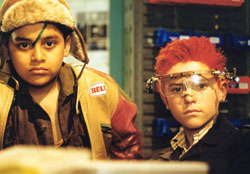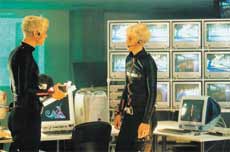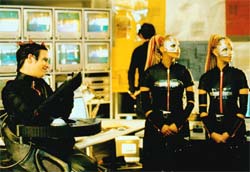 Love em or loathe em
Love em or loathe em
Computers have been around for a few years now. Some people like them and some people hate them.
After the virus there was no use for computers. The only ones that were able to work were laptops that could run off batteries. Jack and Dal got a laptop to work but in the end there wasn’t much use for one. Ellie started a magazine type journal called The Amulet that she published and printed for the people.
But the internet was gone, there was no email and the games were limited. Basically they were no use.
So came a change in lifestyle – no more spending late nights chatting to people in chatrooms or researching school projects. The information age had given way to mis-information.
Old forms of communication were back in business including writing (with a pen!) and more communicating through speech, voice, meetings and votes.
The Techno’s Technology
With the arrival of the Techno’s, computers have made a comeback – sort of. The Techno’s rely on computers for much of what they do. But what do they do?
 The Techno’s have the city under surveillance and this relies on the technology of computers and now they’ve turned the power on they have an endless supply to run them.
The Techno’s have the city under surveillance and this relies on the technology of computers and now they’ve turned the power on they have an endless supply to run them.
But what else are the Techno’s using computers for? Jay has long wanted to set up a hospital so perhaps they have medical software and information in their computers. They might even have old hospital records.
Their computers could be set up as an education resource and classrooms and schools could be started with the right education software.
Computer games used to be a favourite past time. The Techno’s could be setting up the computers for their own entertainment. Maybe they’re developing new games? Or maybe they want to set up some type of internet that everyone can access.
If everyone had a computer then an internet would be viable. But perhaps the Techno’s have plans of a “Big Brother” kind. With a computer in every house they could keep track of people and what they were doing.
Computer History
The real beginnings of computers started with a mathematics professor named Charles Babbage born 1791. He realised that machines were good at performing tasks repeatedly without mistake and mathematics was often the simple repetition of steps. He started by making a machine called a “Difference Engine” – it was as large as a locomotive and was powered by steam. His next machine was the “Analytical Engine” which was programmed to run by reading perforated cards.
In the ensuing years many more engineers made other significant advances.
 With the start of World War II the governments looking to be a step ahead, increased the funding for computer development. There were now computers to decipher secret codes.
With the start of World War II the governments looking to be a step ahead, increased the funding for computer development. There were now computers to decipher secret codes.
The first calculator was produced in 1944 the purpose of which was to create ballistic charts for the US Navy. It was half as long as a football field and contained about 500 miles of wiring. The machine was slow and inflexible because the sequences of calculations could not change.
By 1948 the transistor was invented. This greatly changed the computer’s efficiency. The transistor replaced the large vacuum tubes that were used in televisions, radios and computers. With the transistor the size of electronic machinery was shrinking. The transistor was at work in the computer by 1956.
By the early 1960’s, computers were starting to resemble what we know today. They had printers, tape storage, disk storage, memory, stored programs and operating systems.
In 1981 IBM introduced the first P.C (personal computer). With the P.C being adaptable for all uses in home, schools and offices the computer was now affordable.
In 1982 there were 5.5 million P.C’s in use – by 1992 there were over 65 million.
Computers have gone from desktop to laptop to palmtop and continue to amaze us with the technology they are capable of.

